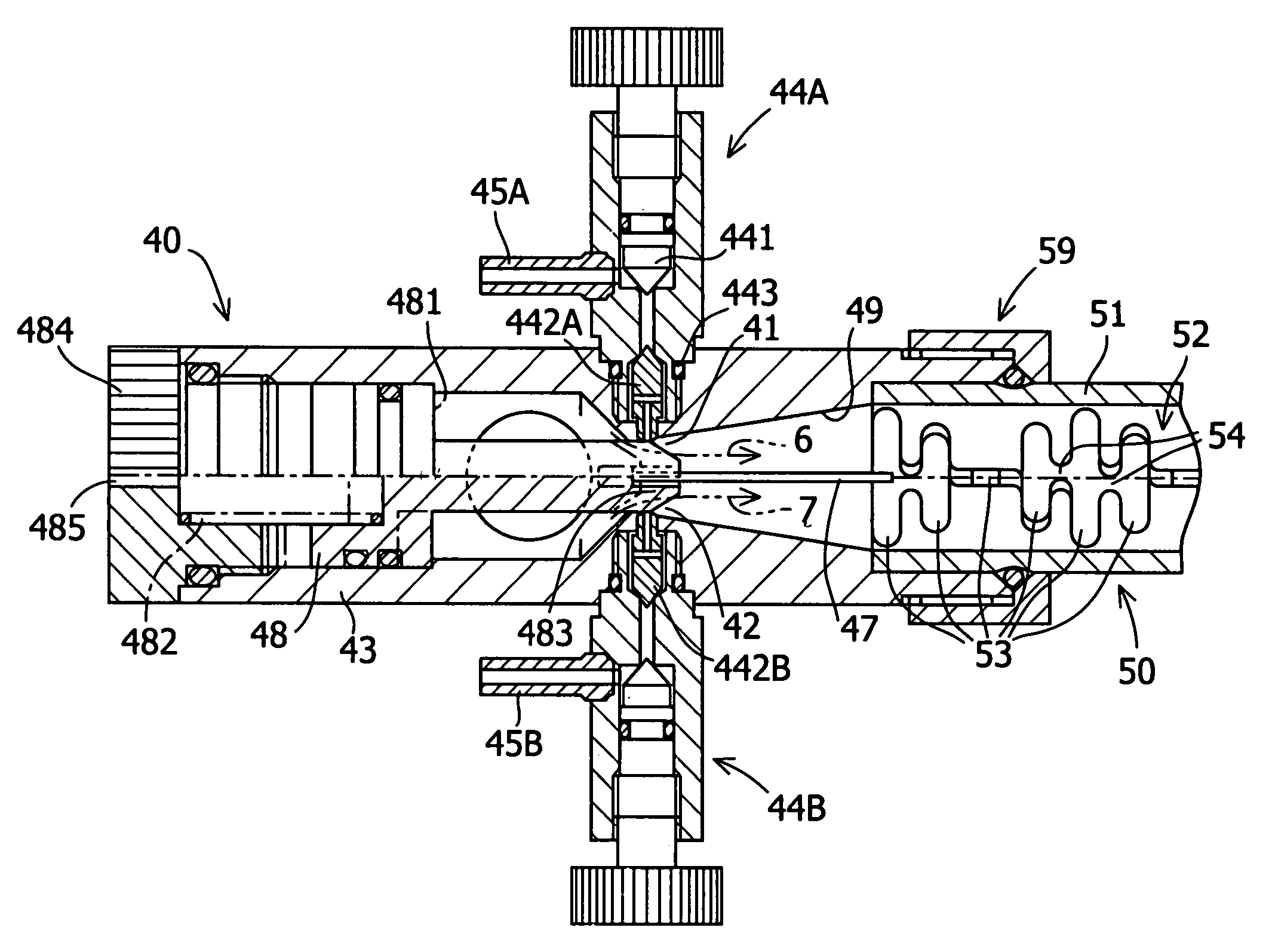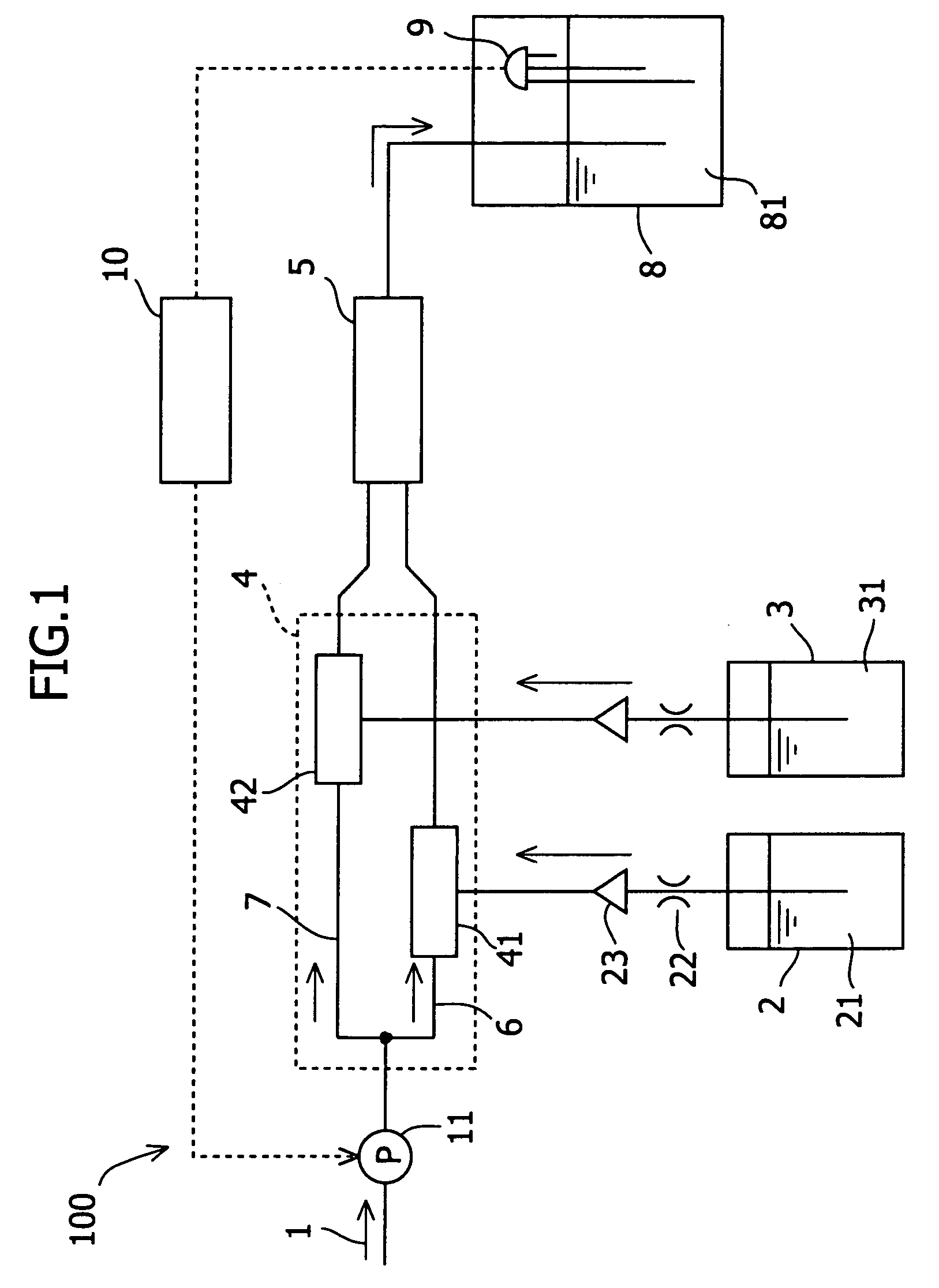Apparatus for producing sterilized water
a technology for sterilizing water and apparatus, which is applied in the direction of process and machine control, instruments, and the nature of treatment water, etc., can solve the problems of insufficient application of chlorine gas, inability to sterilize water, etc., and achieves the effect of increasing concentration and increasing the concentration
- Summary
- Abstract
- Description
- Claims
- Application Information
AI Technical Summary
Benefits of technology
Problems solved by technology
Method used
Image
Examples
first embodiment
[0106]An embodiment of the present invention will be described. FIG. 1 is a schematic system view of an apparatus 100 for manufacturing sterilizing water in accordance with one embodiment of the present invention.
[0107]In the apparatus 100 for manufacturing sterilizing water, raw water 1 is sucked and supplied under pressure by a suitable pump 11, and to the supplied raw water 1, an acid solution 21 is fed from an acid tank 2 to form an acidic water, and further a chlorine-based solution 31 is fed from a chlorine-based solution tank 3, by which sterilizing water is manufactured. The configuration is such that the quantity of feeding of the acid solution 21 is controlled by a flow rate regulating portion 22, and when the water flow is shut off by a check valve 23, a flow path 6 is isolated from the acid tank 2.
[0108]The raw water 1 is not subject to any special restriction, and pure water, city water, river water, underground water, and the like are suitably used according to the app...
second embodiment
[0125]Another embodiment of the present invention will be described. FIG. 6 is a schematic system view of an apparatus 101 for manufacturing sterilizing water in accordance with another embodiment of the present invention.
[0126]In the apparatus 101 for manufacturing sterilizing water, as in the apparatus 100 for manufacturing sterilizing water, the raw water 1 is sucked and supplied under pressure by the suitable pump 11, and to the supplied raw water 1, the acid solution 21 is fed from the acid tank 2 to form the dilute acid solution, and further the chlorine-based solution 31 is fed from the chlorine-based solution tank 3, by which sterilizing water is manufactured.
[0127]In this embodiment, unlike the above-described first embodiment, the raw water 1 flows in a series of flow path, not in plural flow paths. The acid solution 21 and the chlorine-based solution 31 are fed in this order to the raw water 1 flowing in the flow path. The acid solution 21 is fed to the raw water in a fee...
third embodiment
[0136]Next, the case where the concentration of chlorine-based solution is changed in the apparatus for manufacturing sterilizing water in accordance with the present invention will be explained.
[0137]In this embodiment, the properties of sterilizing water were studied by changing the concentration of chlorine-based solution by changing the dilution ratio thereof. In the present invention, as the chlorine-based solution before dilution, a sodium hypochlorite solution with a concentration of 12% was used, and as the apparatus for manufacturing sterilizing water, an apparatus having a system shown in FIG. 1 and being provided with the feeder and mixer of the examples shown in FIGS. 2 and 3 was used.
[0138]The final concentration of chlorine-based solution and the sterilization power at each concentration were evaluated for each dilution ratio as given in Table 1.
[0139]
TABLE 1Dilution ratio (times)120001200400300 100Concentration (ppm) 10 1003004001200Sterilization powerNormalEnoughEno...
PUM
| Property | Measurement | Unit |
|---|---|---|
| pressure | aaaaa | aaaaa |
| pressure | aaaaa | aaaaa |
| height | aaaaa | aaaaa |
Abstract
Description
Claims
Application Information
 Login to View More
Login to View More - R&D
- Intellectual Property
- Life Sciences
- Materials
- Tech Scout
- Unparalleled Data Quality
- Higher Quality Content
- 60% Fewer Hallucinations
Browse by: Latest US Patents, China's latest patents, Technical Efficacy Thesaurus, Application Domain, Technology Topic, Popular Technical Reports.
© 2025 PatSnap. All rights reserved.Legal|Privacy policy|Modern Slavery Act Transparency Statement|Sitemap|About US| Contact US: help@patsnap.com



